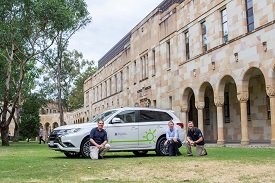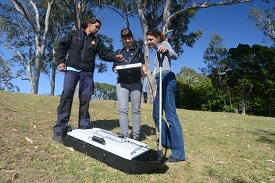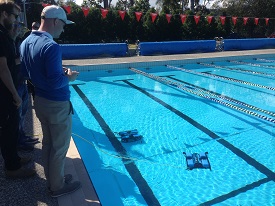Moreton Bay Research Station update
Electric vehicle for MBRS
 In February, UQ Energy and Sustainability and the Faculty of Science provided the station with a new Mitsubishi Outlander plug-in, hybrid electric vehicle. In October, MBRS received a vehicle fast-charging system, allowing recharge of electrical vehicles in 20 minutes. The vehicle does not produce exhaust or engine noise while running on battery power, and helps improve local air quality. When paired with renewable energy for charging, EVs offer the opportunity for carbon-neutral transport. The Island is ideal for electric vehicles, with only 26 kilometres between townships, thus allowing the car to travel several trips between townships on no fuel. The car is available for hire to station users and has been popular with researchers and groups using the station.
In February, UQ Energy and Sustainability and the Faculty of Science provided the station with a new Mitsubishi Outlander plug-in, hybrid electric vehicle. In October, MBRS received a vehicle fast-charging system, allowing recharge of electrical vehicles in 20 minutes. The vehicle does not produce exhaust or engine noise while running on battery power, and helps improve local air quality. When paired with renewable energy for charging, EVs offer the opportunity for carbon-neutral transport. The Island is ideal for electric vehicles, with only 26 kilometres between townships, thus allowing the car to travel several trips between townships on no fuel. The car is available for hire to station users and has been popular with researchers and groups using the station.
Ground Penetrating Radar (GPR)
 This year, the station received a new state-of-the-art Mala Ground Explorer GPR device available for research and education for UQ staff and students at Moreton Bay Research Station. Ground Penetrating Radar is a non-destructive method of imaging the subsurface using radar pulses with many applications across a number of fields, including geology, archaeology and environment. Recent users of the equipment include Professor Alan Gontz from San Diego State University, in conjunction with the School of Environmental and Earth Sciences (SEES). Alan explained that a GPR works very similarly to a depth sounder, sending out a ping and measuring the time for it to return. MALA has chosen to shorten the time window for this system to 200ns. In the sands of Stradbroke Island, that might mean penetration of 8.5m in good conditions. With the 160MHz antenna, it is capable of imaging up to 28m. The machine has also been used by Dr Kelsey Lowe from the UQ Culture and Heritage Unit, School of Social Science, who was working in conjunction with Quandamooka Yoolooburrabee Aboriginal Corporation (QYAC) around Minjerribah (North Stradbroke Island) this year. The machine is available for UQ research and teaching via the station and includes several accessories to cope with the different environments on the Island.
This year, the station received a new state-of-the-art Mala Ground Explorer GPR device available for research and education for UQ staff and students at Moreton Bay Research Station. Ground Penetrating Radar is a non-destructive method of imaging the subsurface using radar pulses with many applications across a number of fields, including geology, archaeology and environment. Recent users of the equipment include Professor Alan Gontz from San Diego State University, in conjunction with the School of Environmental and Earth Sciences (SEES). Alan explained that a GPR works very similarly to a depth sounder, sending out a ping and measuring the time for it to return. MALA has chosen to shorten the time window for this system to 200ns. In the sands of Stradbroke Island, that might mean penetration of 8.5m in good conditions. With the 160MHz antenna, it is capable of imaging up to 28m. The machine has also been used by Dr Kelsey Lowe from the UQ Culture and Heritage Unit, School of Social Science, who was working in conjunction with Quandamooka Yoolooburrabee Aboriginal Corporation (QYAC) around Minjerribah (North Stradbroke Island) this year. The machine is available for UQ research and teaching via the station and includes several accessories to cope with the different environments on the Island.
Blue ROV
 Moreton Bay Research Station and Heron Island Research Station purchased two underwater Remotely Operated Vehicles (ROVs) for research and teaching in 2019. The ROVs will increase research and teaching capabilities at UQ. These ROVs are considered entry-level equipment, and will provide increased opportunities for underwater research and also build user confidence in operating this new technology. The ROVs will also extend the ability researchers have to conduct underwater activities that are at depth and high risk in nature. These vehicles include a platform to attach sensors, video and mechanical manipulating devices for a variety of purposes across a range of scientific and engineering-related activities. The ROV will additionally be able to collect small objects from the reef with the aid of a grabber arm, providing another potential use for the submersible craft for our visiting research teams.
Moreton Bay Research Station and Heron Island Research Station purchased two underwater Remotely Operated Vehicles (ROVs) for research and teaching in 2019. The ROVs will increase research and teaching capabilities at UQ. These ROVs are considered entry-level equipment, and will provide increased opportunities for underwater research and also build user confidence in operating this new technology. The ROVs will also extend the ability researchers have to conduct underwater activities that are at depth and high risk in nature. These vehicles include a platform to attach sensors, video and mechanical manipulating devices for a variety of purposes across a range of scientific and engineering-related activities. The ROV will additionally be able to collect small objects from the reef with the aid of a grabber arm, providing another potential use for the submersible craft for our visiting research teams.
During August the Science Workshops and Research Station staff attended a three day Blue ROV workshop at UQ, where they learned to assemble, maintain, service and operate the ROVs in the UQ pool.
MBRS Open Day
 MBRS Open Day was held on 30 November 2019, celebrating 57 years of UQ research and teaching in Dunwich. The day was an enjoyable experience for locals and visitors alike. The feedback received from the community has been fantastic! Visitors consisted of a mixture of both Minjerribah (Stradbroke Island) locals and a number from the greater Brisbane area. This event has helped to increase community awareness of Quandamooka’s beautiful environment and rich culture. This year Quandamooka elder, Aunty Bernice Fischer, gave the Welcome to Country, and spoke about her uncle Jack Borey, whom the marker buoy in the Rainbow Channel is named after. Traditional Owners Matthew Burns and Patrick Coolwell shared traditional knowledge of the land and sea by taking visitors on the Goompie Trail. They also participated in cruises on the bay aboard the Moreton Bay Education Centre vessel, highlighting Quandamooka’s beautiful environment and rich culture. The public lecture series included a full day of research talks held in the Station library. Topics ranged from dolphins in Moreton Bay, and impacts of marine debris, through to how swamps have recorded environmental change on Minjerribah.
MBRS Open Day was held on 30 November 2019, celebrating 57 years of UQ research and teaching in Dunwich. The day was an enjoyable experience for locals and visitors alike. The feedback received from the community has been fantastic! Visitors consisted of a mixture of both Minjerribah (Stradbroke Island) locals and a number from the greater Brisbane area. This event has helped to increase community awareness of Quandamooka’s beautiful environment and rich culture. This year Quandamooka elder, Aunty Bernice Fischer, gave the Welcome to Country, and spoke about her uncle Jack Borey, whom the marker buoy in the Rainbow Channel is named after. Traditional Owners Matthew Burns and Patrick Coolwell shared traditional knowledge of the land and sea by taking visitors on the Goompie Trail. They also participated in cruises on the bay aboard the Moreton Bay Education Centre vessel, highlighting Quandamooka’s beautiful environment and rich culture. The public lecture series included a full day of research talks held in the Station library. Topics ranged from dolphins in Moreton Bay, and impacts of marine debris, through to how swamps have recorded environmental change on Minjerribah.
